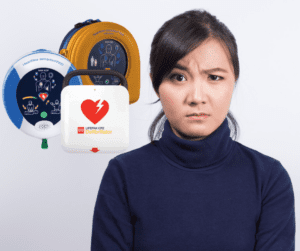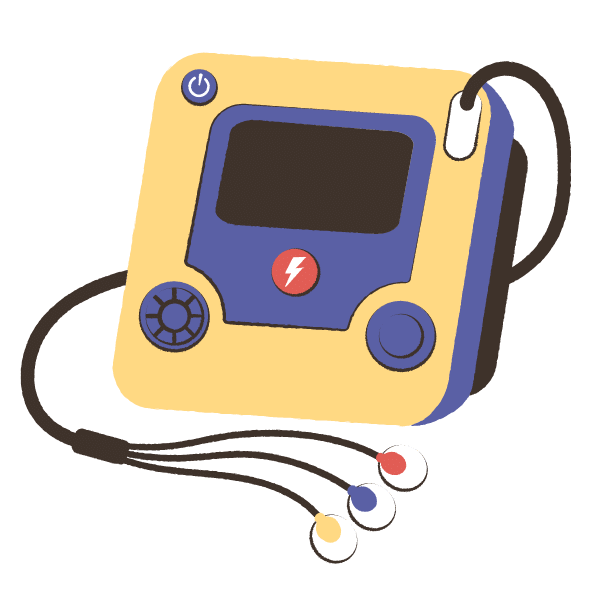What Defibrillator Should I Buy?

What Defibrillator Should You Buy?
Defibrillators save lives.
There’s no doubt about it.
But choosing the right one can be daunting.
It’s like choosing a new mattress, or a new car. There’s plenty of options, but it can be hard to know the difference.
So we’ve created this guide to help make the world of defibrillators easy.
We’ll take you through the key features to look out for and explain what they mean.
Understanding the Basics
Automatic vs Semi-Automatic Defibrillators
An AED is a life-saving device, and the choice between automatic and semi-automatic models is crucial. Here’s what you need to know:
Automatic Defibrillators: These AEDs analyze the heart rhythm and automatically deliver a shock if needed, without any intervention from the user. They are typically more suitable for untrained individuals.
Suggested Models: Heartsine 360p, Lifepak Cr2, Zoll AED Plus, Defibtech Lifeline
Semi-Automatic Defibrillators: These require the user to press a button to administer the shock after the device has analyzed the heart rhythm. They offer more control but might be better suited for those with some training.
Suggested Models: Heartsine Sam Pad 350p, Heartsine 500p, Lifepak Cr2 essential, Defibtech Lifeline View


Reader Technology
In a high-pressure situation like cardiac arrest, having the right guidance can make a big difference.
That’s where reader technology comes into play.
This innovative feature coaches the rescuer to perform CPR more effectively, guiding them to push harder, faster, slower, and so forth.
It’s like having a seasoned paramedic standing next to you telling you when to push harder and push faster
Heartsine Samaritan Pad 500p and the Zoll AED 3 are among the leading models that incorporate reader technology. By coaching you through the process, these devices increase the chance of successful resuscitation, even for someone with minimal training.

WiFi Connectivity
The integration of WiFi in defibrillators has revolutionized the way emergency services and safety managers can operate. Here’s why WiFi connectivity matters:
Quick Data Transfer: Emergency services can download vital data swiftly, speeding up the response time.
Easy Tracking: Safety managers can efficiently track and manage defibrillators, ensuring that they are always in optimal condition.
Models like Lifepak CR2, with full WiFi capability, and Heartsine, with an optional WiFi gateway, are at the forefront of this technological advancement. The WiFi feature aligns with the demands of modern businesses, making these models a smart choice for those looking to stay ahead in safety management. Please note that Wifi features vary depending on the model.

Child Mode
Safety extends to all, and children are no exception. Drownings, car accidents and inherited heart conditions are just some reasons why a child may need a shock.
Of course, a childs heart and body are more sensitive to electrical shock, so rather than deliver an adult sized shock this mode enables the defibrillator to give Lower Shock Delivery.
This mode delivers a shock generally suitable for infants and children up to 8 years, adjusting to their sensitive physiology.
Ease of Access: While some models like Lifepak CR2 offer a one-button solution, others like Heartsine may require special pads for children.
Additional Features
While the features above are central to the selection process, there are other innovative aspects to consider.
ClearVoice Technology: Found in Lifepak CR2 and CR2 Essential, this adapts sound output to surroundings, making instructions more audible in noisy environments.
CPRinsight or Rapidshock Features: Minimizes the time spent analyzing heart rhythm, allowing more time for CPR.
Single Piece Pads: Available in Zoll models, these are cojoined pads that are easier to use, reducing the risk of incorrect application
Screen Options: Some defibrillators, like Zoll AED 3 and Defibtech Lifeline View, feature touch screens for easier management, feedback, and instructions.

Defibrillator Models Overview
For a quick comparison, here’s a table summarizing the main features of each model:
| Model | Type | Reader Tech | WiFi | Child Mode | Additional Features |
|---|---|---|---|---|---|
| Heartsine Samaritan Pad 350p | Semi-Automatic | No | No | No | |
| Heartsine Samaritan Pad 360p | Automatic | No | No | No | |
| Heartsine Samaritan pad 500p | Semi-Automatic | Yes | No | No | |
| Lifepak Cr2 Essential | Both | No | No | Yes | CPRinsight, ClearVoice |
| Lifepak Cr2 | Both | No | Yes | Yes | CPRinsight, ClearVoice |
| Zoll AED Plus | Both | Yes | No | No | Single Piece Pads |
| Zoll AED 3 | Both | Yes | Yes | Yes | Single Piece Pads, LCD Screen, Rapid shock analysis |
| Defibtech Lifeline | Both | No | No | No | |
| Defibtech Lifeline View | Both | No | No | No | LCD Screen |
Let’s Make the Choice
Choosing the right defibrillator is a crucial decision that impacts the safety and readiness of your organization. With the insights provided in this guide, we hope to simplify your selection process. Whether it’s understanding the difference between automatic and semi-automatic models, embracing the latest technologies, or considering special features, you’re now equipped to make an informed choice.
Feel free to fill out our survey at the top of this page for personalized recommendations or reach out to our support team at DDI Safety.
